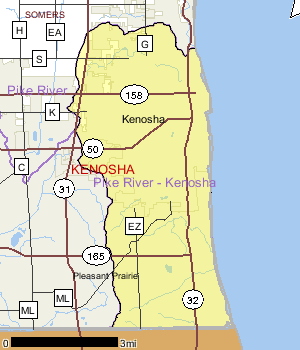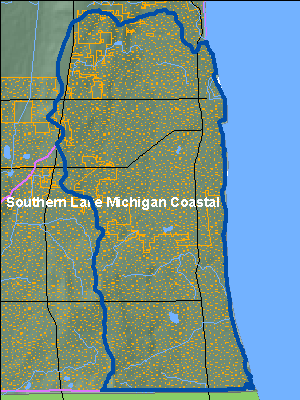
Details
The Pike Creek- Kenosha Watershed is located entirely within Kenosha County and drains portions of the City of Kenosha, the Village of Pleasant Prairie, and the Town of Somers. The watershed actually consists of three sub-watersheds, each draining separately to Lake Michigan. The subwatersheds are Pike Creek, Barnes Creek, and Tobin Creek. Combined, they drain a total area of 27 square miles.
Pike Creek receives the majority of its flow from urban stormwater runoff as it flows eastward through and under the City of Kenosha. Large parts of the stream have been enclosed. Barnes and Tobin Creeks both originate as agriculture drainage, picking up residential runoff before flowing into Lake Michigan.
Urban land uses account for 41 percent of the watershed. Other land uses of the watershed are 20 percent agriculture, 19 percent grassland, nine percent forest, and seven percent wetland. The Pike Creek Watershed has the highest ratio of wetlands to other land uses when compared with other watersheds of the Root-Pike.
Municipalities within the Pike Creek watershed are the Village of Pleasant Prairie and the City of Kenosha.
There are no lakes, named or unnamed, within this watershed.
Date 2002

Ecological Landscapes
The Southern Lake Michigan Coastal Ecological Landscape is located in the southeastern corner of Wisconsin along Lake Michigan. The landforms in this Ecological Landscape are characteristic of glacial lake influence, with ridge and swale topography, clay bluffs, and lake plain along Lake Michigan. Further inland, ground moraine is the dominant landform. Soils typically have a silt-loam surface overlying loamy and clayey tills.
The historic vegetation in the northern part of this Ecological Landscape was dominated by sugar maple-basswood-beech forests with some oak while the southern part was dominated by oak forest, oak savanna and prairies. Wet, wet-mesic, and lake plain prairies were common in this area. Black ash and relict cedar and tamarack swamps were found in this Ecological Landscape. Today, most of the area is dominated by dairy and cash grain agriculture and intense urban development. Only about 8% of the Ecological Landscape is forested. Maple-beech forests are about half of the remaining forest types with the remainder split equally between oak-hickory and lowland hardwood forest types. There are some areas of wet-mesic and wet prairie but only small preserves remain since the landscape is heavily disturbed and fragmented. Because of this isolation, fragmentation, and high level of disturbance, non-native plants are abundant.
Date 2010
Fisheries
Fish species found in Pike, Barnes, and Tobin Creek include those tolerant of environmental stressors, such as the common carp, fathead minnow and creek chub. Other species present in these streams include the brook stickleback, golden shiner, northern redbelly dace, black bullhead, and
white sucker.
Date 2002
River and Stream QualityAll Waters in WatershedBarnes and Tobin Creeks are partially meeting their biological uses. At last assessment, both supported a varied forage fish community. Currently, Barnes Creek is listed in Chapter NR 104, Wis. Adm. Code. as a variance stream, allowing dissolved oxygen levels as low as 2 mg/L. However, the
impending changes to NR 104 will most likely reclassify Barnes Creek as Warm Water Forage Fish stream without the variance. Pike Creek has not been evaluated, and is defaulted as capable of supporting a warm water sport fish community.
However, due to urban stormwater runoff and stream enclosure, what fish community that is present is expected to be severely impacted. No
streams in this watershed are on the states impaired waters (303(d)) list.
Date 2002
Watershed Trout StreamsWatershed Outstanding & Exceptional ResourcesLakes and Impoundments
Impaired Waters
List of Impaired Waters Watershed RecommendationsGLPF2018_LM1802_ChlorideStudy
Date
Status
Chloride Impact Study for the Southeastern Wisconsin Region
6/1/2018
In Progress
Date
Status
In 2008 13% of Great Lakes beaches exceeded health standards; approximately 90% of those exceedances were attributed to unknown pollution sources. In this project, sanitary surveys will be conducted at all impaired beaches [CWA, 303(d)] in SE WI to identify pollution sources and drive mitigation.
10/1/2010
Proposed
SEWRPC WQM Planning, Grants support, TMDL work
Date
Status
sewrpc area WQM planning
12/31/2020
In Progress
AWQMP Program - SEWRPC
Date
Status
sewrpc program 2021
1/1/2021
In Progress
 Watershed History Note
Watershed History NoteThe Pike River watershed in Kenosha County has a long history of human habitation. Pre-Clovis culture settlements were discovered in the greater Kenosha area in the late 20th century. These prehistoric settlements date approximately to the era of the Wisconsin glaciation. Paleo Indians first settled in the area at least 13,500 years ago. The Potawatomi originally named the area gnozhé - place of the pike.
The early name by the Ojibwa Indians is reported as Masu-kinoja. This describes the place of spawning trout as "Trout (Pike) come all at same time". There were thousands of fish entering the rivers from Lake Michigan. Harvesting these fish provided food for the coming months. There is also a town of Masu-kegan in Michigan.
The first white settlers were part of the Western Emigration Company. They arrived in the early 1830s from New York state led by John Bullen, Jr., who sought to purchase enough land for a town. Thwarted in Milwaukee and Racine, the group arrived at Pike Creek in June 1835, and built log and later frame homes. The first school and churches followed, with platting completed in 1836. As more settlers arrived and the first post office was established, the community was known as Pike.
In the ensuing years the area became an important Great Lakes shipping port, and the village was once again renamed, this time to Southport, which is still the name of a southeast-side neighborhood, park, and elementary school, as well as several businesses.
In 1850, another change brought the growing city, and later the county, its current name of Kenosha, which is an Anglicized version of Kinoje, the Chippewa word for pike or pickerel. Kenoshans often refer affectionately to their city as "K-Town" and "Keno".
Date 2011